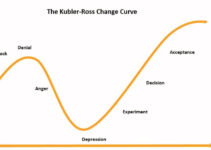BCG (Boston Consulting Group) created the dice framework model to evaluate and foretell the success rate of the change project. The term “dice” is the acronym of elements; duration, integrity, commitment, and efforts. The four dice elements let the management know whether the organization is moving in the right direction or not. Today, we’ll discuss the dice framework change management; elements, benefits, formula, and challenges of dice framework in change management.
Dice Score Calculating Formula
- Dice Score Formula = D + (2XI) + (2XCI) + C2 + E
D stands for duration, I for integrity, C for commitment, and E for efforts
How to measure the result from the dice score; keep in mind the following;
- A 7-14 score means that the project is a success
- 14-17 score means that the risk of failure
- An above 17 score means that you are close to a loss
Tips for Launching the Dice Framework Model
- Analyze every element of the dice framework before launching the change project and make necessary changes
- Employ Dice after implementing the changes to know the weaknesses and failures of the project
- Pay heed to all 4 four elements of the dice framework
- Follow the objective approach
- Try your best to win
Elements of Dice Framework Change Management
Let’s discuss the four main elements of the dice framework change management model and they’re as follows;
Duration
When it comes to estimating the duration of the change project, then it baffles the change leaders and the company’s management. If the change project takes a long time to implement, then it amplifies the risk factor of its success. Therefore, change leaders should regularly perform reviews and analyze the growth of long-duration change projects.
If the change leaders review the performance of the change project monthly and weekly, then it keeps the change project on the right path. However, if the change leaders aren’t reviewing the change project regularly, the project won’t reach the deadline and result in failure.
Keep in mind following following questions;
- How often do you review the performance of the change project
- Reviewing the progress regularly or not
- The time it takes to complete the project
Reviewing 1 once a month; or after four months; D = 1 means that you are reviewing once a month.
Integrity
Integrity comprises of motivation, skill, expertise, and motivation level of employees, team members, and change leaders. It plays a key role in the success and failure of the change project; companies should be very careful while choosing their change team members. However, the change team would decide while going through the difficult phase and the company’s capability of resolving the conflict. The best and most open communication would lead the change project towards success.
Keep in mind the following questions while measuring integrity;
- Whether the change leaders and change team members have the required skills and expertise or not
- Do they have the required and needed motivation level or not
While scoring the integrity; know the following parameters;
- 80% skill of change team members = 1
- 60% skill = 2
- 40% skill level = 3
- 20% skill level = 4
Commitment
While implementing the changes, the company requires 100% commitment from all the stakeholders from top to bottom. The company’s top leadership should show commitment by openly discussing the reasons and purpose of the change project. Employees and team members could show their commitment by performing their daily routine tasks honestly.
Keep in mind the following questions while measuring the commitment level of employees and leadership;
- Senior management and leadership are effectively communicating the change plans and their purpose with the team members; and to what extent
- Change message is convincing; to what extent
- Management is listening to the feedback of employees; and to what extent
- Their support of the change project
While measuring the score and commitment level of employees and leadership, keep in mind the following;
- Excellent message clarity = 1;
- Good clarity = 2;
- Ordinary clarity = 3;
- Poor message clarity = 4
- Excellent relationship with team = 1;
- Good relationship = 2;
- Ordinary relationship = 3;
- Poor relationship = 4
Efforts
Efforts outline how much work you are doing for the change project. Team members and employees need to go the extra mile to perform their daily routine tasks and activities. For instance, it could be roundabout 10% extra work from their routine tasks; above 10% extra work would increase the employee resistance level.
Keep in mind the following questions while analyzing the efforts of employees and management;
- Employees performing the extra work; and how much
- The comfort level of employees with the extra work they’re doing
While measuring the efforts of employees, keep in mind the following parameters;
- Extra workload is under 10% = 1
- 10-20% workload = 2
- 20-30% workload = 3
- 30-40% workload = 4
Benefits of Dice Framework in Change Management
Some of the main benefits and advantages of the dice framework in change management; they’re as follows;
- Employs and focuses on hard factors to measure the performance level
- You can easily communicate these factors and they impact the success of the change project
- Offers evidence and reason to change leaders to execute changes or make an alternative plan
- Guiding change leaders to make informed decisions and analyzing the change project
Challenges of Dice Framework in Change Management
Some of the main challenges and disadvantages of the dice framework in change management; they’re as follows;
- Completely avoids soft factors that are equally significant for the change project
- Scoring personally needs to be highly objective; any type of subjective approach impacts the results
- Only analyzes and evaluates the success and performance of the change project; it doesn’t offer solutions
Conclusion: Dice Framework in Change Management
After an in-depth study of the dice framework change management; we have realized that the dice framework model guides you on how to measure and analyze the success of the change project. If you are learning about the dice framework in change management; then you should keep in mind the abovementioned advantages; disadvantages; elements; questions, and score-measuring criteria.
Ahsan is an accomplished researcher and has a deep insight in worldly life affairs. He goes Live 3 days a week on various social media platforms. Other than research writing, he’s a very interesting person.


